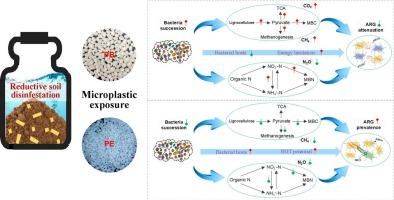Bacterial communities and CN cycling drive microplastic-specific trade-off between greenhouse gas emissions and antibiotic resistance genes during reductive soil disinfestation
IF 5
2区 农林科学
Q1 SOIL SCIENCE
引用次数: 0
Abstract
Microplastics coexist with various soil degradations in intensive agricultural systems. Reductive soil disinfestation (RSD), a microbial community-based strategy, is widely used to alleviate soil degradation. However, microplastics' impact on soil bacterial communities and C![]() N cycling during RSD remains unclear, with such changes potentially further affecting greenhouse gas emissions and the prevalence of antibiotic resistance genes (ARGs). A microcosm experiment was conducted using biodegradable poly(butylene adipate-co-terephthalate) (PB) and non-degradable polyethylene (PE), with six treatments: untreated control (CK), PB- or PE-amended soil (PB, PE), straw incorporation with flooding (RSD), and RSD combined with PB or PE (PBRSD, PERSD). Results showed that compared to CK, RSD increased CH4 emissions by 12-fold without affecting CO2, whereas PBRSD enhanced both by 20-fold and 29 %, respectively, while PERSD increased CH4 by 6.1-fold. Though RSD elevated N2O emissions by 89 % relative to CK, microplastics mitigated this increase by 29 % in PBRSD and 17 % in PERSD. RSD reduced soil ARG abundance from 0.18 % (CK) to 0.16 %, with PBRSD intensifying this reduction but PERSD counteracted it. Enrichment of key bacterial taxa (e.g., Clostridium, Paenibacillus) was closely linked to the coregulation of ARGs (multidrug, aminoglycoside) and C
N cycling during RSD remains unclear, with such changes potentially further affecting greenhouse gas emissions and the prevalence of antibiotic resistance genes (ARGs). A microcosm experiment was conducted using biodegradable poly(butylene adipate-co-terephthalate) (PB) and non-degradable polyethylene (PE), with six treatments: untreated control (CK), PB- or PE-amended soil (PB, PE), straw incorporation with flooding (RSD), and RSD combined with PB or PE (PBRSD, PERSD). Results showed that compared to CK, RSD increased CH4 emissions by 12-fold without affecting CO2, whereas PBRSD enhanced both by 20-fold and 29 %, respectively, while PERSD increased CH4 by 6.1-fold. Though RSD elevated N2O emissions by 89 % relative to CK, microplastics mitigated this increase by 29 % in PBRSD and 17 % in PERSD. RSD reduced soil ARG abundance from 0.18 % (CK) to 0.16 %, with PBRSD intensifying this reduction but PERSD counteracted it. Enrichment of key bacterial taxa (e.g., Clostridium, Paenibacillus) was closely linked to the coregulation of ARGs (multidrug, aminoglycoside) and C![]() N cycling processes (pyruvate metabolism, methanogenesis, denitrification). Collectively, under RSD, PB enhanced greenhouse gas emissions but reduced ARGs, whereas PE mitigated greenhouse gas emissions yet promoted ARG accumulation, driven by shifts in bacterial communities and C
N cycling processes (pyruvate metabolism, methanogenesis, denitrification). Collectively, under RSD, PB enhanced greenhouse gas emissions but reduced ARGs, whereas PE mitigated greenhouse gas emissions yet promoted ARG accumulation, driven by shifts in bacterial communities and C![]() N cycling. These findings reveal a bacterial community and C
N cycling. These findings reveal a bacterial community and C![]() N cycling driven microplastic-specific trade-off between greenhouse gas emissions and ARGs control under RSD, informing sustainable soil management.
N cycling driven microplastic-specific trade-off between greenhouse gas emissions and ARGs control under RSD, informing sustainable soil management.

在还原性土壤消毒过程中,细菌群落和CN循环驱动温室气体排放和抗生素抗性基因之间的微塑料特异性权衡
在集约化农业系统中,微塑料与各种土壤退化并存。还原性土壤除害(RSD)是一种以微生物为基础的防治土壤退化的方法。然而,微塑料对RSD期间土壤细菌群落和CN循环的影响尚不清楚,这种变化可能进一步影响温室气体排放和抗生素抗性基因(ARGs)的流行。以可生物降解的聚己二酸丁二酯(PB)和不可降解聚乙烯(PE)为材料,进行了6个处理的微观试验,分别是:未处理对照(CK)、PB或PE改良土壤(PB、PE)、秸秆还田(RSD)、RSD与PB或PE复合(PBRSD、PERSD)。结果表明,与对照相比,RSD在不影响CO2的情况下增加了12倍的CH4排放量,而PBRSD分别增加了20倍和29%,而PERSD增加了6.1倍。尽管相对于对照,RSD使N2O排放量增加了89%,但微塑料使PBRSD和PERSD的N2O排放量分别减少了29%和17%。RSD使土壤ARG丰度从0.18% (CK)降低到0.16%,PBRSD强化了这种降低,而PERSD抵消了这种降低。关键细菌类群(如梭状芽孢杆菌、Paenibacillus)的富集与ARGs(多药、氨基糖苷)和CN循环过程(丙酮酸代谢、甲烷生成、反硝化)的协同调节密切相关。总的来说,在RSD下,PB增加了温室气体排放,但减少了ARG,而PE在细菌群落变化和CN循环的驱动下减少了温室气体排放,但促进了ARG积累。这些发现揭示了细菌群落和CN循环驱动的温室气体排放与RSD下ARGs控制之间的微塑料特异性权衡,为可持续土壤管理提供了信息。
本文章由计算机程序翻译,如有差异,请以英文原文为准。
求助全文
约1分钟内获得全文
求助全文
来源期刊

Applied Soil Ecology
农林科学-土壤科学
CiteScore
9.70
自引率
4.20%
发文量
363
审稿时长
5.3 months
期刊介绍:
Applied Soil Ecology addresses the role of soil organisms and their interactions in relation to: sustainability and productivity, nutrient cycling and other soil processes, the maintenance of soil functions, the impact of human activities on soil ecosystems and bio(techno)logical control of soil-inhabiting pests, diseases and weeds.
 求助内容:
求助内容: 应助结果提醒方式:
应助结果提醒方式:


